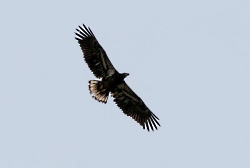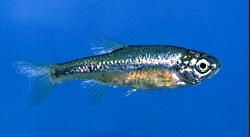
Aquila chrysaetos
Courtesy USDA Forest Service
Dave Herr, Photographer
On a recent Christmas Bird Count, my team witnessed an amazing feat of flight. We parked in a subdivision cul-de-sac to walk into the sagebrush foothills. Overhead we saw two Golden Eagles meet in a talon lock and tumble towards earth. They disengaged moments before crashing and flew off in opposite directions. A minute later and we would have missed it all. So what were they up to? I am not quite sure.
Golden Eagles are supreme flyers. In both courtship and territory displays they steeply dive and swoop upward. During a pendulum display, they dive and rise in one direction then turn and retrace their path. Pairs often play with an object in the sky, repeatedly dropping and retrieving it. The talon lock display is rarely seen, but it too is used both for bonding between pairs and in territorial disputes. We saw the display in December and the birds separated immediately, so we probably witnessed a territorial defense. Golden Eagles require a territory anywhere from 20 to 200 square miles depending on prey abundance. As with most wildlife, loss of habitat is a prime threat.
Three quarters of recorded Golden Eagle deaths can be traced to humans. In treeless areas, power poles provide a convenient perch. When their 7 foot wingspan touches two wires, they are electrocuted. New designs and retrofits for power poles eliminate this problem and the resulting range fires, but many of the older designs remain. Wind farms also kill eagles, but again, new designs and more careful siting are helping to alleviate this problem.
The Golden Eagles’ favorite meal in the West is jackrabbit. However, they are opportunistic foragers and will dine on carrion. If the carcass they feed on was shot, they may ingest fragments of bullets or buckshot that contain lead. Lead poisoning is an excruciating way to die. Carcasses with lead fragments are eaten by many carnivorous birds and mammals who are then poisoned. This winter, 8 Bald Eagles died of lead poisoning at the Wildlife Rehabilitation Center of Northern Utah. We must remedy this problem so we can insure that our skies will always be graced by the grandeur of soaring eagles.
Our theme music was written by Don Anderson and is performed by Leaping Lulu.
This is Linda Kervin for Bridgerland Audubon Society.
Credits:
Image: Courtesy USDA Forest Service, Dave Herr, Photographer
Theme: Courtesy & Copyright Don Anderson as performed by Leaping Lulu
Text & Voice: Linda Kervin, Bridgerland Audubon Society
Additional Reading:
Linda Kervin’s pieces on Wild About Utah
https://www.allaboutbirds.org/guide/golden_eagle/lifehistory
https://www.hawkwatch.org/component/content/127
https://www.peregrinefund.org/explore-raptors-species/Golden_Eagle#sthash.Gqowt1G0.gFqVfifi.dpbs
https://www.deseretnews.com/article/865596763/Lead-blamed-for-latest-bald-eagle-deaths-in-Utah.html





